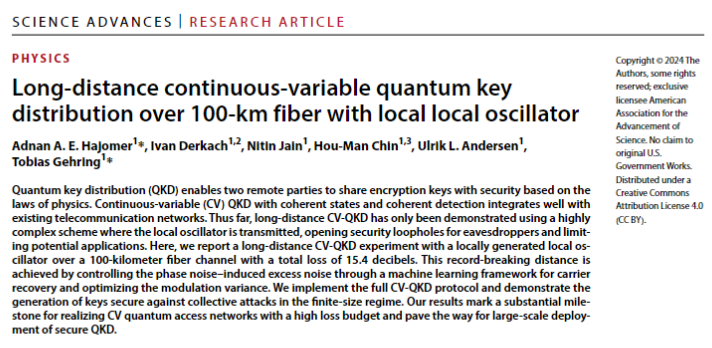Compatible with existing networks! Crossing the 100-kilometer mark, quantum key distribution reaches new milestone
A team of researchers at the Technical University of Denmark (DTU) has successfully achieved quantum secure key distribution by using the Continuous Variable Quantum Key Distribution (CV QKD) technique. They successfully ran the technique over a record distance of 100 kilometers, which is the farthest distance ever achieved using the CV QKD method. One of the advantages of the technology is that it is compatible with existing Internet infrastructure, paving the way for its practical application in enhancing network security.

This achievement marks a major breakthrough in the compatibility of advanced quantum cryptography with existing Internet infrastructure, addressing one of the key challenges facing the field of quantum communications: maintaining quantum coherence over long distances.
Quantum computers pose a potential threat to current algorithm-based encryption, which is critical to securing data transmissions against eavesdropping and surveillance. Although quantum computers are not yet developed enough to decrypt these encryption algorithms, it is widely believed in the tech community that it is only a matter of time before quantum computers achieve this goal. Once quantum computers have cracked the strongest encryption algorithms, all data transmitted over the Internet will be exposed, driving the rapid development of new encryption technologies based on quantum physics principles.
To accomplish this, however, researchers must address a central problem of quantum mechanics: how to ensure that information remains consistent over long distances. Until now, continuous-variable quantum key distribution techniques have demonstrated their efficacy primarily over shorter distances.
"We have achieved several key technological advances, especially in reducing the loss of photons during transmission. In this experiment, published in the journal Science Advances, we succeeded in securely distributing quantum encryption keys over a distance of 100 kilometers via optical fibers." Tobias Gehring, an associate professor at the Technische Universität, said, " This sets a new record."
His goal, together with the research team at the Technical University of Germany, is to be able to use the Internet to distribute quantum encrypted information globally.
When data is sent from point A to point B, it is critical to ensure its security. Encryption ensures that only these two parties have access to the data by combining the use of a security key that is shared with both the sender and the receiver. The confidentiality of the key is crucial during data transmission; once a third party gains access to the key, the encryption is broken. Therefore, secure key exchange is a fundamental and critical step for data encryption.
Quantum Key Distribution (QKD) is a technology at the forefront of research that focuses on securely exchanging encryption keys through quantum mechanisms. This technology relies on the principles of quantum mechanics and uses beams of light emitted by quantum particles called photons to secure the key exchange.
By sending information encoded on photons, the sender and receiver are able to utilize the quantum nature of photons to create a unique shared key. Any attempt to observe or measure these quantum state photons immediately changes the photon's state, thus enabling measurement only through interference of the signal.
"Quantum states cannot be replicated, it's as impossible as trying to copy a piece of A4 paper. Any copying attempt would produce a low-quality copy, which is why the key cannot be copied." Gehring explains, "This property can effectively protect critical infrastructure such as health records, financial systems, etc. from hackers."
Continuous Variable Quantum Key Distribution (CV QKD) provides an advanced method of secure key distribution for data encryption by utilizing the quantum states of photons to generate keys that cannot be cracked. Any interception attempt essentially changes the quantum state of the photon, thus securing the key and preventing data eavesdropping. This mechanism is critical for maintaining the integrity of data transmission and protecting sensitive information.
" One of the advantages of this technique is that it allows us to build an architecture similar to existing optical communication systems. " Gehring commented.
Optical communications, the cornerstone of the Internet, sends data by transmitting infrared light in optical fibers. These fibers act like light guides arranged in a cable, ensuring that we can transmit data across the globe. With fiber-optic cables, data can travel faster and farther, and optical signals are relatively impervious to interference, or noise.
"It's a tried and tested standard technology. As a result, we don't need to invent new technology to use it to distribute quantum keys, and it significantly reduces implementation costs. In addition, we can operate at room temperature." Gehring added: " While CV QKD technology works better over shorter distances, our goal is to extend that distance. And the realization of 100 kilometers is a big step in the right direction. "
Tobias Gehring, Associate Professor at the Technical University of Germany, emphasized that the project aims to use the Internet to facilitate the dissemination of quantum encrypted information on a global scale. The success or failure of the project hinges on the ability to address photon losses and other challenges encountered when transporting quantum states over long distances.
By addressing three key factors, the research team succeeded in extending the distance for quantum encryption key exchange. First, machine learning was used to identify interference in the system at an early stage, effectively countering so-called "noise"-which can originate from electromagnetic radiation, for example, and can distort or destroy quantum states in transit. Early detection of noise helps to reduce its impact more effectively.
In addition, the team has improved its ability to correct errors that can occur during transmission, which can be caused by noise, interference or hardware defects.


DSP program for a long-range local local oscillator (LLO) continuously variable quantum key distribution (CV-QKD) system








